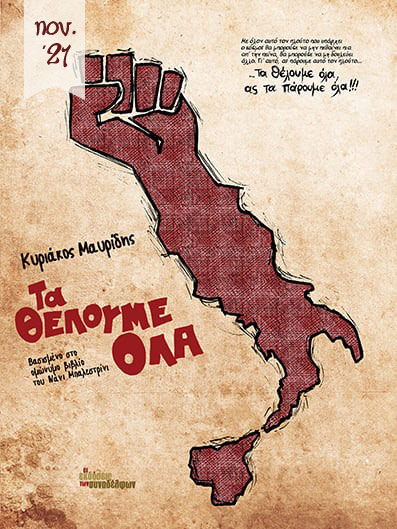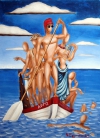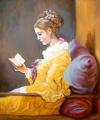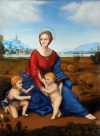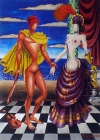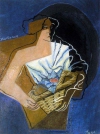Displaying items by tag: copy
It is a reproduction of a painting by Nikos Engonopoulos. Its name is Argo.
There are not many changes with the original work -perhaps the most notable one is the change of the second word on the boat (I replaced Argo (which is the name of the boat) with the word Σπεύδω (spevdo -which literally means I'm hurrying up -the opposite of the literal meaning of the word Argo -which is "I am delaying").
If you want to find out more about the painter and poet N. Engonopoulos you can visit the site: http://www.engonopoulos.gr/_homeEN/
Copies of works that appear on the film The Mystery of Picasso.
All works belong to private collection.
About the movie: Music by Georges Auric, who also scored Cocteau’s movies. Shot by Claude Renoir, who also shot a handful of his uncle Jean’s films and also Barbarella. Director Clouzot made this between a mystery thriller and a spy parody.
A nice companion movie to La Belle noiseuse, another one where we actually watch a painting being created in real time. The movie introduces Picasso, then cuts to a full shot of a transparent canvas, Picasso’s brush (or pen, whatever) on one side, the camera on the other, so there are a few over-the-shoulder shots but mostly we’re seeing (a mirror image of) the canvas with the painting magically appearing upon it. There are edits and time-lapse too – areas of wet paint dry in an instant, whole areas of color or pattern suddenly appear. Sometimes we’re clearly watching a painting from start to finish in real time, and sometimes they’ll tell us in voiceover how long it actually took.
There’s no narration – rather what little verbal information we learn is in the form of (obviously staged) conversations between artist and camera crew. My favorite bit is when Picasso asks for a very large canvas and suddenly the movie goes into Cinemascope ratio (‘scope was less than three years old, so still a cool novelty).
It’s a suspense/art film as you watch the work in progress and try to wonder what PP is planning, where the painting is heading (even he doesn’t seem to know half the time), and when it’s “done”. The wonder of this film is that the paintings exist through time – most of them look great when complete, but the process and intermediate steps are just as great… you’re not just waiting for good art to appear at an unknown end point, you’re watching it all along. The filmmakers keep it short (<80 minutes), the music styles vary greatly between paintings, and there are some bursts of crew participation, like the time they pressure PP to finish a painting before their reel of film runs out.
(Info by http://deeperintomovies.net/)
Two copies of the painting Young Girl Reading, c.1770 by Jean-Honoré Fragonard (info by http://www.nga.gov/collection/gallery/gg55/gg55-46303.html). Both of them were made with acrylics, on on paper (the first one) and the other on canvas (the second one -which also has a more loose technique).
Both copies belong to private collections.
This is a copy of the work Madonna of the Meadows (also known as Madonna with the Christ Child and Saint John the Baptist or Madonna del Belvedere) which is a 1506 painting by Raphael (info: http://en.wikipedia.org/wiki/Madonna_del_Prato_%28Raphael%29)
Unfortunately due to the shininess of the oil colors I had some problems with the photo I placed here. I took the shot from the side without flash which resulted on a more blurry and contrasted image
Three copies of the painting Tree of Life, by Gustav Klimt (http://www.oil-painting-shop.com). The changes between them are mostly in colors and the general hue of the image.
All works belong to private collections (friends).
Copies of paintings by Vincent van Gogh. The paintings are La méridienne, also known as La sieste, d'aprés Millet was painted from December 1889 - January 1890 (info http://www.flickr.com/photos/wallyg/1389660699/), Wheat Field with Cypresses (1889) (info https://en.wikipedia.org/wiki/Wheat_Field_with_Cypresses) and a Self-portrait (1889) (info https://en.wikipedia.org/wiki/Van_Gogh_self-portrait_(1889) -made on paper).
I admit that I 'm satisfied only by the first copy -the last two fail I think both in color and texture.
These are two different paintings of Caravaggio, that I decided to combine. The first one is called Sich Bacchus (and many scholars believe that is a self prortrait of the artist). The second one is a detail of Mary Magdalene crying in the painting The death of the Virgin. My only change is that the boy at the left doesn't carry flowers but guns and explosives giving another meaning to the weeping of the young girl next to him.
Another painter whose work i'm fond of, is A. Modigliani. I have copied two of his paintings Sleeping Nude with Arms Open (Red Nude), 1917 and Almaisa 1916. Both of the copies were made with oil colors around 2004.
Sleeping Nude with Arms Open (Red Nude)
This famous painting by Modigliani reveals the influence of Van Gogh. The works of Modigliani and Van Gogh are often regarded as distorted. The picture reflects the accuracy of a camera. It is obvious that physically the artist was very close to the model. The viewer of the painting may wonder as to what kind of relationship the artist may have had with his model or why he chose not to show what is behind their eyes.
This painting is a fine example of Modigliani’s figure painting with an elegant arresting arrangement of curved lines and planes as well as a striking idealization of feminine sexuality.
Modigliani is regarded as master of ‘painting of the sensual.’ In this painting, the naked woman is depicted as sleeping. She is unblemished and has all symmetries. The artist has shown his subject in the foreground in close-up, as if he is forcing the viewer to react emotionally. The sinuous lines are inviting and the breasts are like eyes, to cachet on.
The prevailing atmosphere is peaceful, quite and cozy. She is at ease, with her eye-lids shut and a wry smile. The abstraction of the woman makes the voyeurism more acceptable and invites longer viewing time.
The plasticity and rich warm color palette are salubrious and calm. This painting is a fine example of ‘Sensual Art.’ The painting is pedagogic to the general society as it is categorized as “Art.” It is erotic, inspires to be sexual, but offers more of a narrative than just pornography’s narrow one.
(Info by http://www.famous-painters.org)
Almaisa
These two works are reproductions of paintings by the cubist painter Juan Gris. The woman with the basket (1927) is made with tempera (40 x 30cm) while Bottle and Fruit Dish (π.35 x 45cm) and Water bottle, Bottle and Fruit Dish (1915) with oil colors (1m x 70 cm). Both paintings were made before 2004.
Now in Bookstores
We Want Everything
the publications of colleagues, Nov. 2021
Summer of 1969, Italy. A year after May '68, FIAT workers began a dynamic and unmediated strike against their powerful boss. Their struggle marked the beginning of a decade of workers' and students' mobilizations and the rise of the Autonomy movement. It was characterized by many as the last invasion of the working class into the sky. Last ... let's hope until the next one ...
